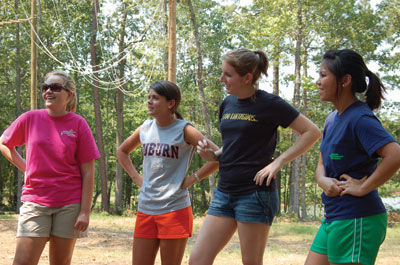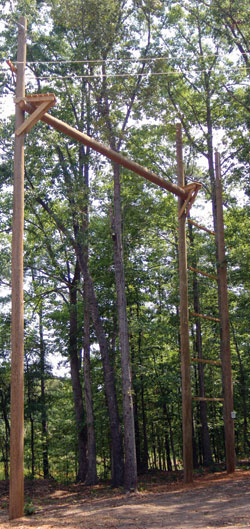On the Ropes
New Ropes Course Hones Leadership Skills

Walk the Topsy Turvy. Swing on the Flying Squirrel. Scale the Dangle Duo. Cross the Wild Woosey.
All of these adventures and more are available on the AU Office of the Dean of Students’ challenge course located just north of the AU campus.
The challenge course is an activity designed to teach students, business associates and organization members good communication, leadership and teamwork skills as well as how to work together under stressful situations. It is intended to "challenge them outside their box," says Robert Hensarling, director of Land and Resource Management for the College of Agriculture and AAES, who helped establish the course.
Several AU campus groups supported the building of the course, including the Student Government Association, ROTC and the colleges of business and agriculture. "The College of Agriculture has been wonderful in helping us out in any way," says Laura Herring, AU challenge course program adviser.
According to Herring, the elements of the course teach participants leadership by stressing the components of good leadership–cooperation, communication, faith and trust.

Different parts of the course offer different options. The high course, which includes such elements as Lily Pads, Topsy Turvy and Diminishing Return, is broken into "static" and "dynamic" sections. Static means the person is hooked to the course; dynamic means he or she is attached to another person on a belay system.
"It takes your team on the ground to help you finish the element," says Herring.
The most physical element in the high course is the Dangle Duo, which requires two individuals to climb as high as they can on a ladder-like element. The rungs get farther apart as the climbers increase their height. "The Dangle Duo is good for partnerships," says Herring. "It requires them to learn to work together."
On the low course, the Wild Woosey can be the most challenging. Participants must depend on teamwork to finish. Participants must literally lean on their partners while trying to reach the end of the element, and both must rely on spotters. This element teaches individuals to have faith in each other.
Moby Deck is a team balancing act, in more ways than one. Each team member must balance on a revolving deck, balance the deck and balance the leader. "We can’t all lead all the time," says Herring. Part of being a good leader is knowing when to take a step back and let someone else lead–to do what is beneficial for the entire group.
Another element is The Wall, which all team members scale as a planning project. Before the exercise begins, the group must plan how to get each member over the wall. They look at the strengths and weaknesses of the team and plan accordingly.
All elements are "challenge by choice," says Herring. No one is forced to participate. Instead, individuals are encouraged to push past fears so they can say "I did it."
"A participant doesn’t have to be in top-notch physical condition," says Herring. "The focus of the course is on the development of participants’ leadership skills."
The course, which is located on AU land north of Auburn, has already been used by several groups and is available for use by non-campus groups. It can be reserved in conjunction with a picnic pavilion for all-day events, and seminars can be arranged, with the AU College of Business providing specialized training.
Plans for expansion of the course also are under way. On-site restrooms, a parking lot and wheelchair accessibility should be finished this fall. And a series of "low" elements are also in the plans. A leadership reaction course, an Army-based course that is highly team-oriented, will be added within a year.
For more information on the AU challenge course, contact Herring at herrilm@auburn.edu.
